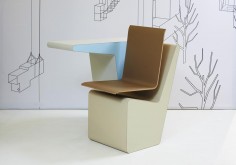STUDIO MAKKINK & BEY
source: droog
Droog’s collaboration with Dutch designer Jurgen Bey started in the early nineties and resulted in the design of, amongst others, Kokon furniture, Tree-trunk bench and St. Petersburg chair for the Droog collection.
Born in Soest, the Netherlands in 1965, Jurgen Bey is one of the most renowned Dutch designers. He studied at the Design Academy Eindhoven and has since run studios independently or in collaboration with others, while teaching at the Design Academy Eindhoven in previous years, and currently, at the Royal College of Art in London. Bey’s work includes product, furniture, interior and public space design, and is produced by his studio, or by companies such as Droog, Royal Tichelaar Makkum, and Moooi. Bey is known as a critical designer, driven to understand the world and to question it in a unique manner. He has been awarded the 2005 Prins Bernard Cultuurfonds Award, the 2005 Harrie Tillie Award from Stedelijk Museum, Roermond and the Interior Award 2003 from Lensvelt/de Architect, for his meeting room for the Interpolis company.
In 2002 Bey formed Studio Makkink & Bey with Rianne Makkink. Working together and supported by a design team, they analyze content and search for the relation of things and their users. In their words, “town planning, architecture and landscape architecture are indissolubly connected to products and can be in symbiosis; the lamp has influenced architecture and the built home the products for the interior.”
.
.
.
.
.
.
.
source: domusweb
Rotterdam-based Studio Makkink & Bey has recently designed the new SideSeat chair, as the latest addition to a range of products designed for Dutch product design manufacturer Prooff, namely the EarChair and the WorkSofa.
“In our work for Prooff we investigate knowledge landscapes with collective indoor and outdoor spaces where work and life fold into one,” state designer Jurgen Bey and architect Rianne Makkink. “Recurring themes are the library and the campus as ultimate places for obtaining and sharing knowledge. This issues subjects such as archiving, meeting, mobility, transmission and storage of knowledge.”
With their SideSeat, these themes have come together in the shape of a self-contained desk, cupboard and chair, which nevertheless allows for a myriad configurations, and a flexible relationship with the surrounding working space. A compact workstation, SideSeat features a swivel chair, allowing to create privacy in public areas. The table can be used as an arm rest, a side table or a small desk. SideSeat is available in a range of pastel and earth tones, and seeks to become a “stimulus for creativity and focus for staff.”
.
.
.
.
.
.
.
source: fortunegreece
Στην πολυθρόνα καθόμαστε για να ξεκουραστούμε και στην καρέκλα του γραφείου για να δουλέψουμε. Τι θα λέγατε, όμως, για ένα κάθισμα που ευνοεί και τα δύο; Που επιτρέπει την αλλαγή της στάσης ανάλογα με τη διάθεση, το χώρο που βρισκόμαστε ή τις ανάγκες της στιγμης.
Ο Ολλανδός Jurgen Bey σχεδίασε, μαζί με τη Rianne Makkink το Side Seat, ένα κάθισμα που θυμίζει το φοιτητικό μας θρανίο με τον βραχίονα, και έχει κάτι από το κάθισμα Eames. Μπορεί κανείς να το στρέψει προς το μικρό ατομικό τραπεζάκι για φαγητό ή εργασία, ή μακριά από αυτό για μιλήσει με κάποιον ή απλά να ξεκουραστεί.
Σύμφωνα με τους δημιουργούς το Side Seat θα ταίριαζε θαυμάσια σε ημι-δημόσιους χώρους εργασίας όπως είναι τα open space γραφεία, τα λόμπι των κτηρίων, βιβλιοθήκες και αεροδρόμια. Η αλλαγή του προσανατολισμού του καθίσματος δίνει μια πολυχρηστικότητα που δεν έχουν τα απλά καθίσματα, ενώ ο μικρός αποθηκευτικός χώρος στο πλάι είναι εύκολα προσβάσιμος.


